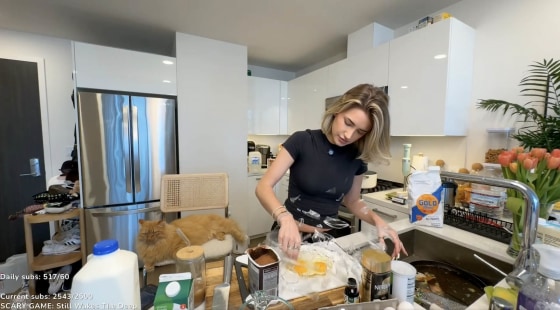A streamer’s shocking moment in the kitchen has netizens putting their lab goggles on.
On March 30, influencer Asta Bush, who also goes by the name Ambush, posted a clip from a March 29 cooking livestream, in which she’s making an Oreo brownie recipe and discussing the price of eggs as she cracks a pair of them into a glass bowl. Moments after she touches the bowl’s interior, it suddenly explodes, sending shards of glass all over her work surface.
The moment went viral everywhere, with tens of millions of views across Instagram, Threads and X.
“I was honestly so confused because it went from 0 to 100 so fast,” Bush tells TODAY.com. “I was just trying to process what was happening but nothing really made sense.”
Bush says her viewers were just as in shock as she was, writing in to express concern for the streamer and her curious cat.
She quickly cleaned up the mess and finished the stream as normal, but her viewers — and the rest of the internet — couldn’t let the shocking moment go.
The theories poured in:
- “My guess, something on her bracelet shattered the glass.”
- “Glass can store stress from damage and misuse.”
- “Bowl was hot and eggs cold”
- “She wears rings, diamonds or ceramic can break glass like this.”
- “Probably has some porcelain in her jewelry which can shatter glass with ease.”
- “a quantum phenomenon.”
- “I bet her dishwasher is running so the countertop is warm.”
- “The cat did that with its telekinesis powers.”
- “This is insane and can only be explained by ghosts.”
Bush says the bowl (which was from Target) was not hot, and that she was wearing silver and gold jewelry — no diamonds or porcelain, which can both damage glass.
So, what’s her theory? “I think during the time I had it the glass probably expanded or there was tension that eventually caused it to explode like that,” she says.
Glass experts weigh in on the viral moment
As it turns out, Bush is not far off.
John Mauro, professor and head of Department of Materials Science and Engineering at Penn State, explains to TODAY.com that there are a few different types of glass based on their stress profiles, or how strong they are.
“The most basic type of glass would be an annealed glass product,” Mauro says, adding that the process to make this type of glass results in a strong finished product. “That’s good in the sense that you don’t have to worry about catastrophic breakage, like what happened with that bowl.”
Mauro explains that while he can’t be sure how the bowl broke without examining the wreckage, it could be a manufacturing defect or the result of a surface crack that came from handling.
“Anytime you’re banging a glass bowl against something, you could be introducing some microscopic damage and those little cracks can grow if they are subject to additional stresses,” Mauro continues, and hitting it against a surface or object could be all it takes.
“It looks like it’s tempered, by the way it broke by exploding,” Sean Salstrom, an artist, associate professor and head of the glass department at Rhode Island School of Design, tells TODAY.com.
Tempered glass works well in consumer products because it breaks more safely than typical glass. A very strong example of this type is Gorilla glass (which Mauro co-invented), of which many phone screens are made.
Salstrom says that if any part of the surface of tempered glass gets scratched or stressed, though, the whole sheet will go.
“It’s the same way that your automotive windshield works, although that one also is sandwiched with a layer of safety adhesive that keeps it from going all over the place,” he explains.
“The way I would explain it is glass can be like a coiled-up spring and it can hold a lot of energy,” Josh Raiffe, a glass artist based in New York, tells TODAY.com, adding that sometimes, when glass cools, the outside of the glass cools at a different rate from the inside of the glass.
“When things contract from heat, they squeeze,” Raiffe continues. “So you can have the outside of the glass squeezing on the inside of the glass, and sometimes all it takes is a little difference in heat or a little impact to set off the chain reaction.”
“There could have been a micro-fracture on the skin of the glass,” Salstrom adds. “I did notice when she put the egg in, there was part of a dangling charm on her bracelet that seemed to hit the edge … that that could be enough to to scratch the surface and make it explode.”











